|

by
Claire Mitchell
June 30,
2019
from
Gardener'sCorner Website
Italian version
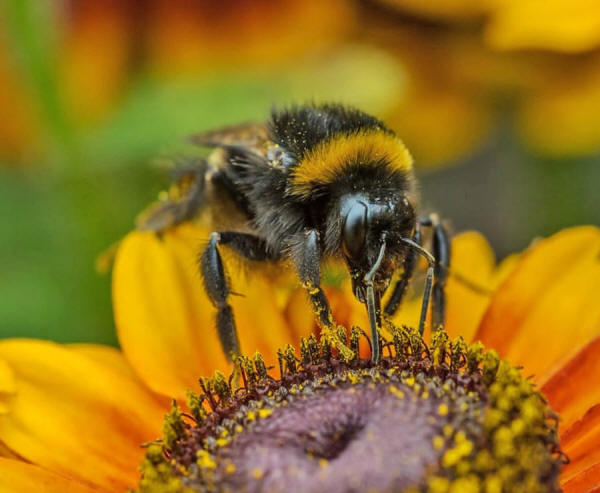
To some, attracting bees into our gardens may seem like some
slightly quirky rural fantasy.
And though it's undeniably satisfying to sit in the garden and watch
colorful bees go about their work, the fact is, they also
desperately need our support.
This guide is for anyone that wants to see more bees in their
garden.
Whether you're a keen gardener or are concerned about the
dwindling bee population (or both) this article is for you.
Facts and
Figures About Bees
Here are some facts and figures taken from a
House of Commons report
on the UK bee population (2017) which outline some of the issues:
-
In the UK, there has been an overall decline in wild bee diversity
over the last 50 years.
-
70 of the 100 crop species that provide 90% of food worldwide are
pollinated by bees.
Why are
pollinators like bees important?
-
Plants that are not pollinated will not set fruits or produce
seeds. Many garden plants and agricultural/horticultural crops need
bees to bring about pollination by transferring pollen from the
flowers' anthers to the stigmas.
These include most tree and soft
fruits, and many vegetables including runner beans, broad beans,
tomatoes, marrows and courgettes.
-
Pollination services are critical for both ecosystem function and
crop production and are estimated to be worth between £430 million
and £603 million a year to UK agriculture.
-
The review estimated that pollinators added approximately £600
million per year to the value of UK crops through increased yield in
oil seed rape and the quality of various fruit and vegetables.
-
Bumblebees and solitary bees that are able to collect nectar and
pollen from a wide range of plants, including garden flowers, are
thought to be maintaining their numbers and distribution.
It is
species that are more selective in their flower-visiting habits, or
have special requirements for nest sites, that have declined and now
have a more restricted distribution.
The UK Bee Population
House of Commons
- Debate Pack Number CDP 2017/0226 - 10 November
2017
Advantages of
Encouraging Bees Into Your Garden
Bees are a highly visible part of our natural world and their daily
activities such as visiting flowers to gather nectar and pollen are
a vital component of our ecological system.
These substances provide
food for our bees as well as for the larvae in their hives or nests.
And in addition, by moving from flower to flower, they act as vital
pollinators of numerous garden and wild flowers.
Along with other
insects such as,
flies, beetles, butterflies and moths,
...bee
pollination is also essential for the healthy cropping of most
fruits, and even some vegetables.
With some bee populations now falling to dangerous levels,
attracting bees into your garden will help these vital pollinators
to survive and help to sustain the essential diversity of our
planet's ecology.
The rich diversity of plants growing in Britain's
gardens (and practically in any garden in the world) means these outside spaces, and the gardeners who tend them,
are a rich resource indeed.
It has been said that there are often
more pollinators active in our nation's gardens than are available
in the surrounding agricultural landscape.
Clearly, bees will enhance the pollination and biodiversity within
your own garden. But sustaining bee populations will also preserve a
vital link in the natural food chain.
That in turn will also help to
preserve the quality of the landscapes for us and for future
generations.
Another benefit of encouraging bees into your garden is that you
will give yourself the opportunity to watch and study these
fascinating creatures at close quarters.
And as you learn more about
their habits and behavior, you will come to respect these tiny
pastoral powerhouses even more.
As William Shakespeare once wrote:
'Where the bee sucks, there suck
I.'
But which bee did he mean? And how many kinds of British bees
are there...?
Which Bees
Will You be Likely to Spot in Your Garden?

There are more than 250 species of bee occurring in Britain
(or 16,000 known species of bees in seven recognized biological
families
worldwide).
To keep things simple, they are best thought of as belonging to one
of three distinct groups.
1) Bumblebees
There are around 25 British bumblebee species, some of which can
only be found in very localized habitats.
Around mid-summer,
when a
bumblebee nest is at peak capacity, it will
harbor
around 100-200 bees.
In most gardens there could be around 8 common social bumblebee
species as well as 4 cuckoo species. Young fertile female
bumblebees (queens) are the only ones that overwinter - so there
is no need to store food to sustain a colony.
The queens of most
species take winter refuge by burrowing into the soil to
re-emerge on a sunny spring day.
It is the task of these queens to find suitable nest sites to
raise the first generation of larvae. Once these bumblebees
mature into adult workers, they assume the job of collecting
nectar and pollen, leaving the queen free to carry on laying
eggs.
Male bumblebees and next year's queens will have been born
by mid to late summer. Then as the September-October months
arrive, the nests are in decline with the ageing queen, males
and worker bees all dying off.
If you should discover a bumblebee nest in a compost heap, or
some other inconvenient location, try to leave the nest until
the bees naturally die off in late summer/early autumn.
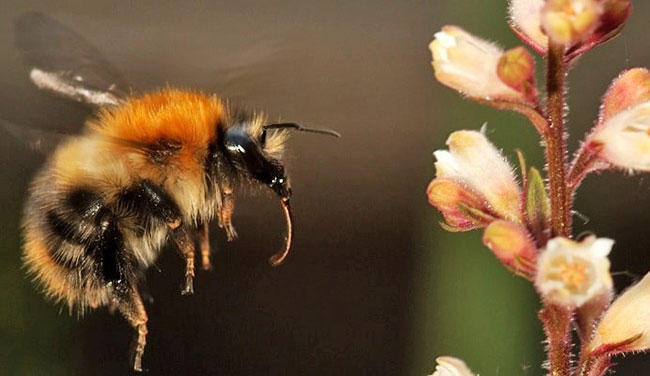
A Typical Bumble Bee
2) Solitary bees
There are about 224 species of
solitary bee in Britain.
They do
not share the same social structure as the bumblebee. Each
female builds a nest, breeds and dies before the new generation
of her family arrives.
Even though they are described as
solitary bees, some soil-nesting species may still nest in close
proximity
Other solitary bees may nest inside hollow plant stems, within
soft rotten wood, take advantage of soft sandy cliffs or use the
holes beetles have previously bored in dead wood.
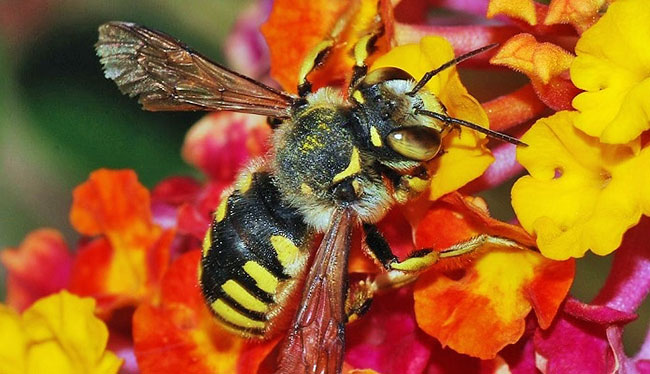
A
Solitary Bee
3) Honeybees
The honeybee is the classic social bee and lives in colonies of
up to 60,000. It is also the bee that
produces honey, and thus
is the species of most interest to beekeepers.
Within the hive, there will be the following types of bee:
-
Queen bee - She rules the hive, makes decisions, and lays her
eggs.
-
Drones - The typical hive will contain several hundred male
honeybees.
-
Workers - The majority of the hive population will consist of
infertile female worker bees. Their various tasks include
building honeycombs, gathering nectar and pollen, defending the
hive against predators, and of course looking after the colony's
larvae.
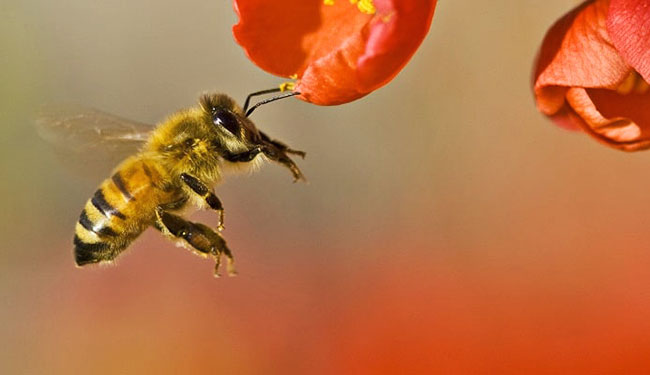
Honey Bee collecting pollen
Why is Our Bee
Population in Decline?
Like many other wildlife species, bees are facing a whole range of
threats, not only here in the UK but also in many other parts of the
world.
The major factors involved are:
-
loss of bee habitats
-
the
effects of our
changing climate
-
the widespread use of agricultural
and other
pesticides
-
the impact of bee
diseases
While any one of these factors would pose significant problems for
bees, it is the way these hazards combine and interact which has led
to the decimation of bee species.
As a result of these influences,
it is believed nearly 10% of European wild bee species may soon
become extinct.
And what harms our bees is also likely to wipe out
other pollinator species.
1) Habitat Loss
Our UK landscape has been subject to a number of major changes
in land use.
These include a switch to intensive farming methods
and unsympathetic urban development. As a result, rich,
pollinator-friendly habitats have been lost or subject to
significant fragmentation.
The predictable outcome has been the
degradation of the diverse food sources bees depend upon to
maintain a healthy diet.
Bees require an abundance of flowers to sustain their foraging,
as well as access to hedges, soil and vegetation which they use
for nesting and as safe places to shelter.
But, according to
Friends of the Earth, 97% of our once-abundant wildflower
meadows have vanished since the Second World War.
This has left
our native bees with just the tattered remnants of what was once
their natural habitat.
With the loss of vital farmland habitat, bees and other wildlife
are now increasingly dependent upon the availability of
protected wildlife sites.
Despite this, the UK government's own
statistics record that a mere 6% of habitats protected by EU
legislation are rated as being in 'favorable condition'.
i) The impact
of intensive farming
Intensive agricultural practices favoring large open fields
and a sterile monoculture are responsible for the
disappearance of our traditional rural landscape:
hay and
flower meadows, lush hedgerows, a variety of tree species as
well as other habitats such as ponds and low-lying water
meadows.
The restoration of our farmland to include more of these
natural habitats could benefit farmers by boosting the
wholly free natural services our wildlife can provide:
e.g.
pollination and keeping down farm pest populations via
natural predation.
ii) Our
changing land use
New and intensive forms of land use have been responsible
for the fragmentation and destruction of much natural
habitat.
More sustainable types of housing and urban
development must avoid damaging our surviving wildflower
meadows.
There should also be a commitment to incorporate
'green infrastructure' which can be of vital importance to
bees and wildlife populations.
And given they are responsible for the management of
significant green and semi-wild spaces - including local
parks and allotments, roundabouts and highway soft verges - local authorities too have an important role to play in
safeguarding native pollinators.
2) The Disruptive
Effects of Climate Change
As seasons shift and winters become wetter and
warmer,
scientists believe climate change may be disrupting bee nesting
and their emergence in spring.
This change may also be affecting
the flowering schedule of bee food plants.
Some bee species are
adapting by moving northwards, but not all bees will be able to
make such adjustments - bumblebees in particular may be unable
to migrate north.
If apple trees are in blossom when the bees are inactive, this
will affect a bee food resource. However, it will also have a
significant impact upon pollination and subsequent crop yields.
There could also be implications for bee health.
3) Pesticides Harm
Bee Health
Even when used properly, pesticides can harm bees, limiting
their breeding success and weakening their resistance to
disease.
Pesticide exposure has been found to impair honeybee
navigation as well as bumblebee reproduction, and can render
solitary bees sterile.
Though pesticides are designed to target harmful pests, their
toxicity and intensive use are also wiping out bees and other
beneficial insects.
Neonicotinoids are particularly lethal. Bees
feeding on contaminated pollen or nectar suffer damage to their
central nervous system.
This disrupts essential survival
behaviors like feeding, homing, foraging and reproduction.
The spraying of herbicides in parks and on highway soft verges
also limits the supply of forage plants which bees and
pollinating insects use as a food source to sustain them
throughout the year.
4) Bee Pests and
Diseases
Beekeepers monitor their honeybee colonies to guard against
pests and disease.
One major threat is the
varroa mite - a small
parasitic creature which attaches to a honey bee, causing a
strength-sapping disease - while fungal diseases can soon spread
through a whole colony.
There is some evidence that certain honeybee diseases can also
infect wild bumblebees.
So by managing honeybee health,
beekeepers can safeguard wild bees as well as their own domestic
hives.
5) Invasive
Species
While some foreign bee species, like the
Carpenter Bee, adapt to
the British Isles and cause no problems, this is not the case
with every visitor.
For instance, the
Asian Hornet is a recently
discovered arrival which could cause major harm to British bees
if it ever became established.
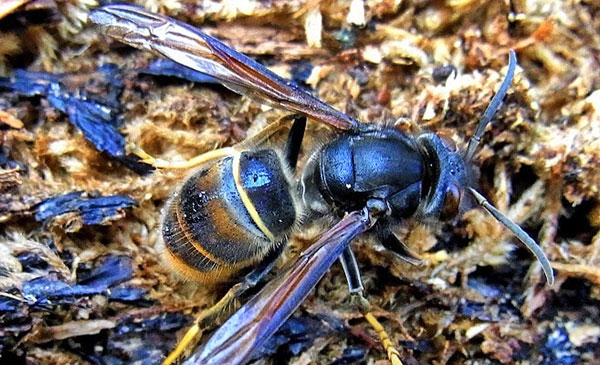
Asian Hornet
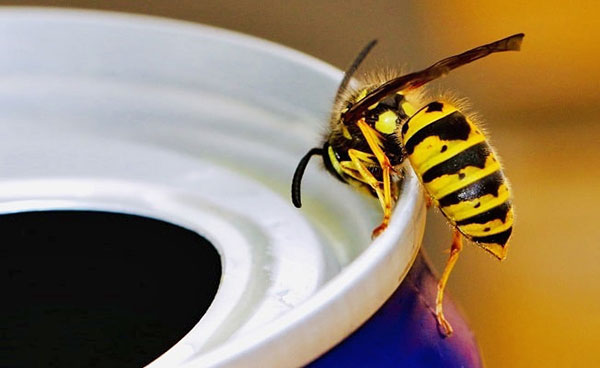
A Common Wasp
How to Attract Bees
to Your Garden
Like all creatures, bees need,
food, water and shelter to thrive...
So the best way to
encourage bees to visit your garden is to provide them with these
three essentials.
1) Food Plants For
Bees
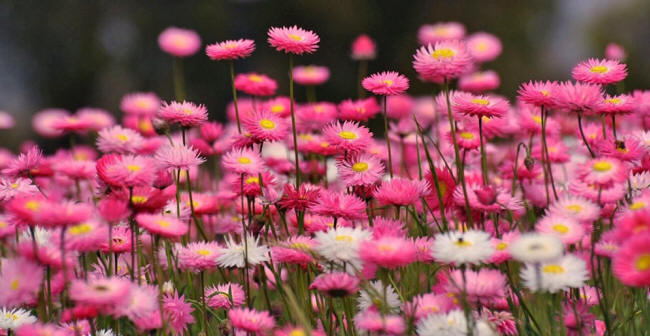
You can plant
bee-friendly trees, shrubs and plants in your garden. With
different bee species active at different times of the year,
it's helpful to provide blooming plants and trees at every
season.
Bees forage for nectar and pollen:
Sugar-rich nectar
supplies their energy needs, while pollen is a source of protein
and oils.
Bees come in all sizes, and with varying tongue
lengths - so aim for a diverse range of flowers with different
features.
To help choose which will be best options for your garden, below
is a list of bee-friendly flora arranged by season.
The list below is in addition to
my top 20 bee-friendly plants.
SPRING
-
Trees and
shrubs
Pussy Willow: Grow this small tree with fluffy catkins
to feed queen bumblebees as they create new colonies in
early spring.
Apple or crab-apple: Bees are major pollinators of these
trees with attractive pink and white blossoms.
-
Flowers
Lungwort: With spotted leaves and deep blue and purple
flowers, this is an easy plant to grow in your garden.
Crocus: A colorful addition to your lawn, crocuses
attract emerging bees who shelter overnight in the
flower cups.
-
Herbs
Marjoram: An aromatic herb with nectar-rich blooms, its
pinky-white drifts will be humming with bees.
-
Fruit &
vegetables
Kale: All bees will flock to the yellow flowers if you
leave one or two plants to 'bolt'.
-
Wildflowers
Cowslip: This meadow flower has yellow, trumpet-shaped
florets which bumblebees will love.
Comfrey: Juicy comfrey flowers soon re-fill with nectar,
which makes them very appealing to bumblebees.
SUMMER
-
Trees and
shrubs
Lavender: Its perfumed scent and purple flowers are a
magnet for bees. Plant in a sunny spot and prune for new
growth.
Hawthorn: Its spiky branches make hawthorn a good hedge
plant. The white 'May blossom' will attract solitary
bees, and the birds will eat the red fruits.
-
Flowers
Monarda: This 'bee balm' is a striking feature plant
which will draw long-tongued bees.
Phacelia: A sweet-scented bloom for bumblebees which can
also act as a green manure plant.
-
Herbs
Chives: Bees love the nectar in its bunched purple
florets. This green salad herb can be eaten fresh from
the garden.
-
Fruit &
vegetables
Strawberry: Grows well in beds, pots or window boxes.
The tiny yellow florets in the middle are pollinated by
various different bees.
-
Wildflowers
Viper's bugloss: This biennial with tall blue flower
spikes grows easily and self-seeds on sunny, sandy
soils. Highly attractive to many kinds of bee.
Wood forget-me-not: Its delicate sky-blue flowers can
act as ground-cover and self-seed easily. Attracts
solitary bees.
AUTUMN
-
Trees and
shrubs
Abelia: This evergreen 'bee bush' attracts bumblebees
and honeybees to its scented white flowers.
Honeysuckle: Bumblebees seek out this sweet-scented,
vigorous climber by day, as do moths by night.
-
Flowers
Sedum: The nectar-rich flowers of this drought-tolerant
succulent are favourites with honeybees and bumblebees.
Perennial wallflower: Its long-lasting colourful flowers
attract bees of all kinds.
-
Herbs
Sage: Bumblebees and leafcutter bees love the tubular
flower spikes of this aromatic herb.
-
Fruit &
vegetables
Runner/Broad bean: Bright flowers attract pollinating
bees seeking protein-rich pollen.
-
Wildflowers
White deadnettle: In flower most of the year, this is an
important bee plant.
Yarrow: Its white, umbrella-shaped flower-heads are easy
for bees to access.
WINTER
-
Trees and
shrubs
Mahonia: A nectar-rich evergreen. Bright yellow flowers
help overwintering bees.
Ivy: Flowering old growth on this evergreen climber is a
late-year source of nectar for bees.
-
Flowers
Winter aconite: Colorful, bright-yellow flowers bring
color to your winter garden and pollen-rich food for
the bees.
Snowdrop: Snow-white flowers contain abundant yellow
pollen to sustain emerging bees in early spring.
-
Herbs
Rosemary: This long-flowering herb has flared
blue/purple flowers attractive to most bees.
-
Fruit &
vegetables
Raspberry: Early-spring bumblebees are major pollinators
of raspberry flowers.
-
Wildflowers
Lesser celandine: Flowers early with copious yellow
blooms loaded with pollen for your early bees.
Field speedwell: Its dense drifts of delicate blue
flowers often hide queen bumblebees. Food plant for
smaller bees.
2) Water For Bees

Bees require access to water
throughout the year because nectar and pollen contain very
little moisture. They also need water to dilute and access the
crystallized honey they store.
If you use a shallow tray or terracotta saucer as a water
supply, add plenty of pebbles to assist bees and butterflies
which can drown in deeper water.
The only drawback is that such
sources can soon dry out on hot days unless they are
replenished.
One way to avoid this
is to use a deeper container with plenty of corks floating on
the surface which bees can then use as drinking platforms.
3) Shelter For
Bees
a) Build a log
pile
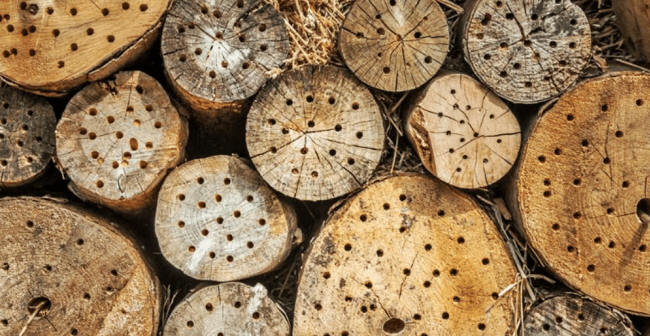
A log pile suited to insects and bees
To provide a natural shelter for bees and other wild
creatures, leave a pile of logs and dead branches in a
corner of your garden.
If possible,
place your log pile under trees or shrubs to give some extra
shade. If you can loosely fill some of the spaces between
the logs with twigs, moss and leaves, this will be
especially appreciated by your bee visitors.
Drilling deep holes into the log-ends will certainly make
the pile more appealing to garden bees and also other
insects.
Over time your logs will be sure to rot and probably
accumulate more leaf litter, which will further enhance the
value of the patch as a wildlife habitat.
Eventually, you
will acquire a messy wood pile which remains undisturbed for
many years - not a particularly difficult management task!
b) Purchase a
custom-made bee sanctuary
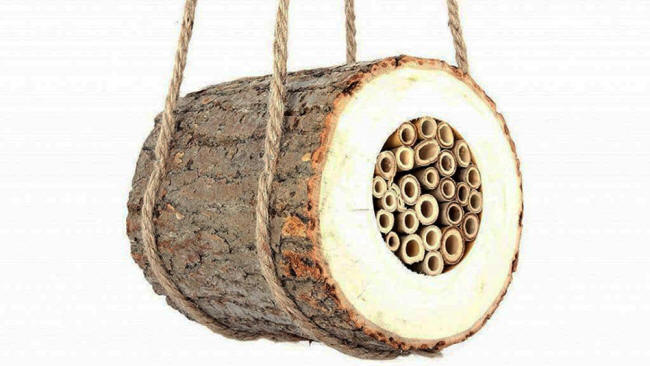
A typical bee log
A garden bee house will provide a suitable nesting site for
some bees, and you will get a lot of pleasure from watching
their activity.
Make sure you choose one which offers good protection from
rainy weather.
Most commercial models will have hollow
bamboo canes to accommodate the bees. If you can get a
variety of different sized holes (diameters between 2-10
mm), you will be able to attract some different bee species.
Your bee 'hotel' should have a solid back to eliminate
draughts, and should be sited against a wall or fence.
Choose a south-facing position which is not subject to
direct sunlight. Also note that this kind of shelter is
designed to house solitary bees only.
It is unlikely to
attract wild bumblebees who prefer larger communal nests not
really suitable for a garden project.
Bee Predators
The natural enemies of bees include some mammals and bird species,
plus a few insects and insect parasites.
In the wild,
badgers are the main bee predator. If they find a nest
they can dig out and eat the contents using their powerful claws.
Protecting any vulnerable nests is a matter of using material which
bees can penetrate, yet keeps the badgers out.
You can sometimes
achieve this using a metal grid.
Other opportunists such as,
fox,
weasel, mice and shrew may occasionally take bees as food.
Birds that will often eat adult bees include shrikes and spotted
flycatchers.
Flying bees are occasionally taken by swallows, while
robins and great tits will catch a bee and then rub it against a
branch to remove the sting before consuming their victim.
Honey
buzzards also specialize in attacking bee nests and consuming the
honey and bee larvae they find inside.
The impact of parasites such as the
varroa mite on wild bees is
little understood, but other predators and parasites include wasps
and flies.
Many of these lay their eggs inside bumblebee nests or on
live bumblebees.
Garden Pesticides
The use of chemicals for garden pest and weed control can be a real
problem for wildlife.
For example, the chemical sprays used to
eliminate aphids and greenfly can kill bees too. If you think it's
essential to use such products, try to apply them at dusk when the
bees will have ceased their activities and retired for the night.
A
mixture of citrus peel and water is often a good way to deal with
aphid infections, and if you can attract ladybirds to your garden,
they are voracious killers of aphid populations.
Chemical control is a controversial and much-studied issue. In
particular, the 'neonic' chemicals (neonicotinoids)
- mainly
thiacloprid and acetamiprid - are thought to cause bees real
problems and have now been banned across Europe.
While flupyradifurone has been marketed as a
'safer insecticide,' some
scientists believe this alternative causes similar problems to the neonicotinoids.
What to do if You
Notice a Bee Swarm in an Undesirable Place
It happens to some of us from time to time.
You come home from
work and notice a persistent buzzing noise from somewhere in
your home.
After careful investigation you find it; a swarm of bees hidden
somewhere you really don't like.
It could be near a doorway or path or even inside your home.
Bees have been known to swarm in the most unusual places,
including on cars (see video below).
In general, it's best to leave the bees alone.
However, while they are endangered they aren't a protected
species.
Rather than forcefully trying to disturb the nest or heaven
forbid, trying to destroy it with wasp killer chemical from the
local DIY store, we suggest you call a local beekeeper.
Beekeepers often remove honey bee swarms and sometimes for free
or for a very reasonable fee.
Solitary bees, bumble bees, wasps and hornets are not usually
favored by local beekeepers. However, you can always take a few
photos of the bees in your home and email them to your local
beekeeper and ask for advice.
Check this video showing
a bee keeper removing a swarm:
| 











